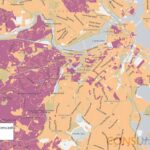# Unveiling LA's Vertical Dimension: How Elevation Shapes the City
Los Angeles is more than just beaches and sunshine; it's a city of dramatic elevation changes, a key factor influencing everything from weather patterns to urban development. This article explores how Los Angeles's varied topography shapes its character, challenges, and future, providing a comprehensive look at how elevation affects daily life in the City of Angels. For a different perspective on urban topography, check out this [Cleveland elevation map](https://www.lolaapp.com/map-of-cleveland/).
## Exploring LA's Elevation: From Coastal Plains to Mountain Peaks
Los Angeles boasts a dynamic topography, a blend of coastal plains, valleys, and mountain ranges, with elevations ranging from sea level to over 10,000 feet in the San Gabriel Mountains. This diverse landscape creates a unique set of opportunities and challenges for the city, impacting weather, infrastructure, and community development. The average elevation of Los Angeles is approximately 472 feet (144 meters), but this number hardly tells the full story.
Imagine experiencing warm beach weather in Santa Monica, then driving just a few hours to go skiing in the San Gabriel Mountains. That's the reality of LA's elevation-driven microclimates. These variations aren't just interesting; they significantly influence local weather patterns, vegetation, and even the types of outdoor activities available.
**Elevation's Impact: Shaping Infrastructure and Emergency Response**
The city's elevation isn't just a scenic backdrop; it directly impacts infrastructure. Constructing roads, buildings, and utility systems across varied terrain requires careful planning and innovative engineering. Drainage systems must account for both flash flood potentials in low-lying areas and the challenges of steep slopes in the hills.
Emergency services also face unique challenges. Wildfires in the Santa Monica Mountains demand a different response strategy than a flood in a low-lying neighborhood. Understanding the terrain is crucial for firefighters, paramedics, and law enforcement to respond effectively, optimizing routes and resource allocation.
**Living High and Low: The Social Impact of Elevation**
Elevation influences where people live and the communities they form. Higher-elevation areas often offer stunning views and a tranquil atmosphere, driving up property values. This creates a mix of housing options, from luxury estates to more affordable alternatives. However, it can also concentrate lower-income communities in areas more vulnerable to environmental hazards, raising issues of environmental justice.
The diverse topography also influences the types of plants and animals that flourish in different areas, creating rich biodiversity. Managing these varied environmental conditions while accommodating a growing population is a constant balancing act.
**Planning for the Future: A Collaborative Approach**
Effectively managing LA's complex terrain demands collaboration and forward-thinking strategies. The following table outlines how different stakeholders can contribute to a sustainable future:
| Stakeholder Group | Short-Term Goals (0-1 Year) | Long-Term Goals (3-5 Years and Beyond) |
| ---------------------- | ---------------------------------------------------------------------------- | ------------------------------------------------------------------------------------------------------------------------------------------------------------------------------------------------------------------------------------------------------------------------------------------------------------ |
| Urban Planners | Implement stricter building codes in flood-prone areas. | Develop comprehensive, elevation-sensitive infrastructure plans accounting for climate change impacts. |
| Emergency Services | Enhance training for varied terrain; improve communication in remote areas. | Invest in advanced technology for disaster prediction and response; optimize emergency routes considering elevation. |
| Environmental Agencies | Implement stricter wildfire prevention regulations. | Build resilient ecosystems; implement conservation programs tailored to different elevation zones. |
| Real Estate Developers | Incorporate elevation-specific safety measures in new projects. | Prioritize housing development in areas with less environmental risk; use sustainable urban design. |
Los Angeles's diverse elevation is integral to its identity, shaping its character and challenges. By addressing urban development and environmental concerns with consideration for elevation, Los Angeles can strive toward a more sustainable and equitable future.
## The Intersection of Topography and Urban Planning in Los Angeles
**Key Takeaways:**
* Los Angeles's topography significantly shapes urban planning, influencing everything from zoning to infrastructure.
* The city's diverse elevations necessitate creative solutions for housing, transportation, and resource management.
* Topography, urban planning, and sustainable development are heavily intertwined in Los Angeles.
* Urban growth boundaries and zoning regulations address challenges raised by LA’s geography.
### Los Angeles: A City Defined by its Terrain
Los Angeles is a city sculpted by dramatic hills, valleys, and a sprawling coastline. This diverse topography influences urban development, from building codes to transportation networks, creating a complex interplay between the natural landscape and the built environment. The steep slopes of the Hollywood Hills contrast sharply with the flat coastal plains, requiring unique planning strategies for each area.
### Zoning in Hilly Areas
Traditional zoning practices struggle to accommodate LA's varied topography. The city is adapting more flexible, performance-based zoning approaches, allowing designers to tailor buildings to specific site characteristics, particularly in hilly regions. Hillside developments require strict regulations regarding slope stability, drainage, and erosion control to prevent landslides and flash floods.
### Infrastructure Challenges
Building and maintaining infrastructure across LA's diverse terrain presents significant challenges. The city's network of winding roads and complex engineering projects reflect the need to navigate steep inclines and varied elevations. Constructing roads, water pipes, and power lines requires substantial engineering expertise and environmental consideration, impacting transportation planning and necessitating a focus on public transit solutions tailored to the city's terrain.
### Environmental Sustainability
LA's topography presents both challenges and opportunities for environmental sustainability. Steep slopes are susceptible to wildfires and mudslides, necessitating careful planning for firebreaks, evacuation routes, and climate change mitigation strategies. Conversely, the city's hills and mountains offer potential for renewable energy projects like solar farms and wind turbines. However, such projects require careful planning to avoid disrupting sensitive ecosystems, making sustainable development a continuous negotiation.
### Housing and Social Equity
The unequal distribution of resources and developable land impacts housing availability and affordability in Los Angeles. Affordable housing projects often struggle to find suitable sites on flat, accessible land, exacerbating existing inequalities. Innovative solutions, such as infill development in denser areas and strategies to make hillside areas more accessible without compromising environmental stability, are needed to address these issues. Social equity remains a key concern for city planners.
### Integrating Topography into Planning
Moving forward, LA's planners must integrate topographic data into decision-making processes. Advanced GIS technology can analyze and visualize the effects of elevation on infrastructure development, environmental sustainability, and social equity, leading to the creation of safer, more resilient, and environmentally conscious communities. Urban growth boundary initiatives also require thoughtful consideration of topography to manage expansion effectively.
## Elevation's Impact: Microclimates and Urban Design in Los Angeles
Los Angeles's varied elevation plays a significant role in shaping microclimates, influencing urban design and planning decisions. The city's unique topography creates distinct localized weather patterns, impacting everything from temperature and rainfall to vegetation and air quality. Understanding these microclimates is crucial for sustainable urban planning and creating livable communities.
Latest posts by Lola Sofia (see all)
- Unveiling ancient roman gladiator helmets design secrets that decided victory or death - August 14, 2025
- Unlocking ancient roman domes: Innovation secrets for modern builds, like the Pantheon - August 14, 2025
- Unlock Ancient Secrets: Ancient Roman Money, Empire’s Rise, a Collector’s Guide - August 14, 2025
















